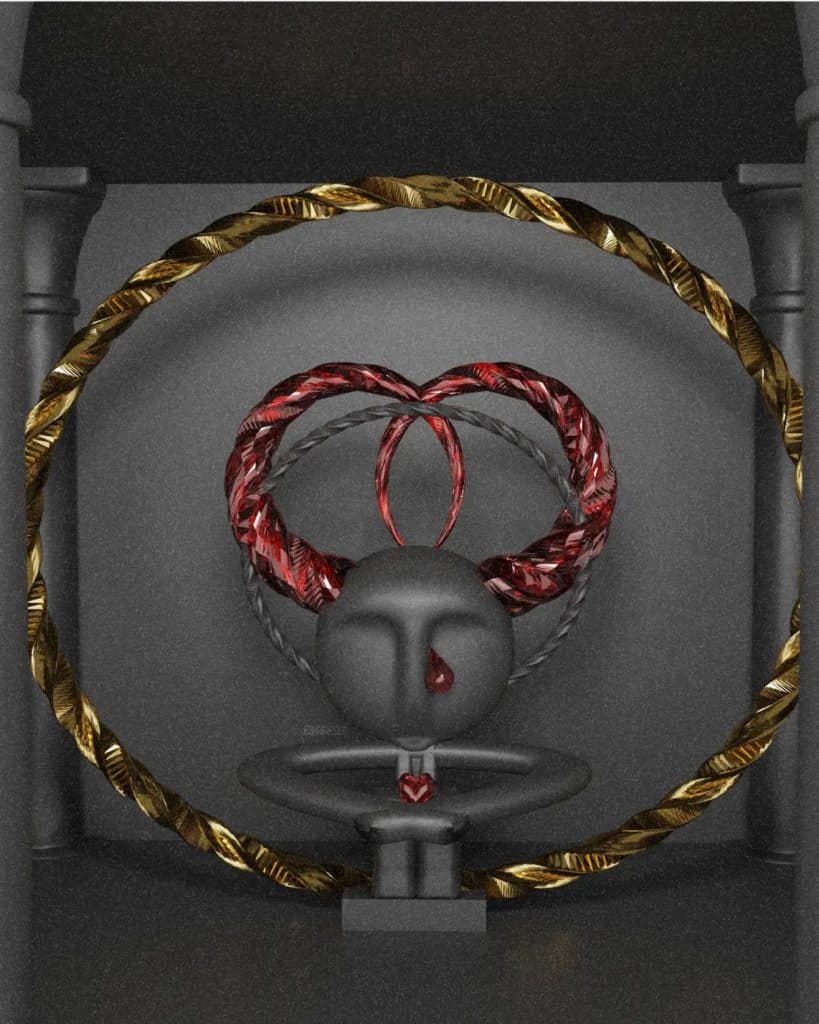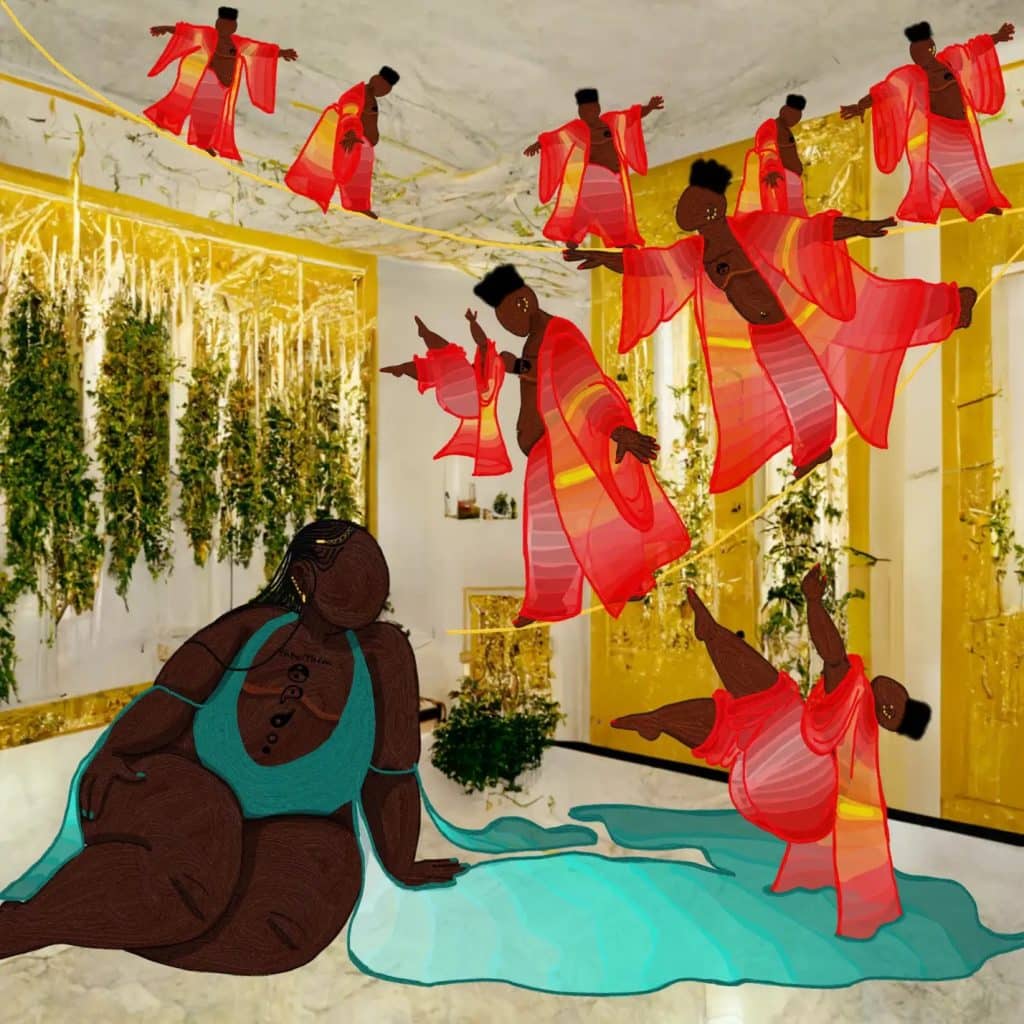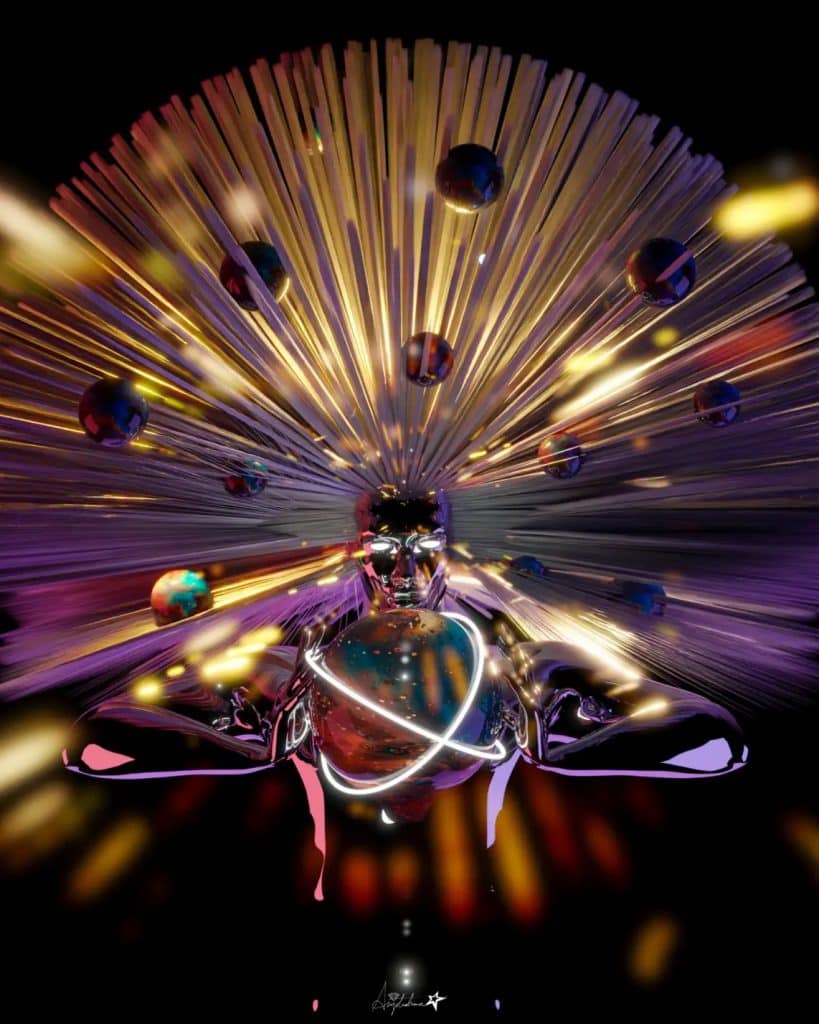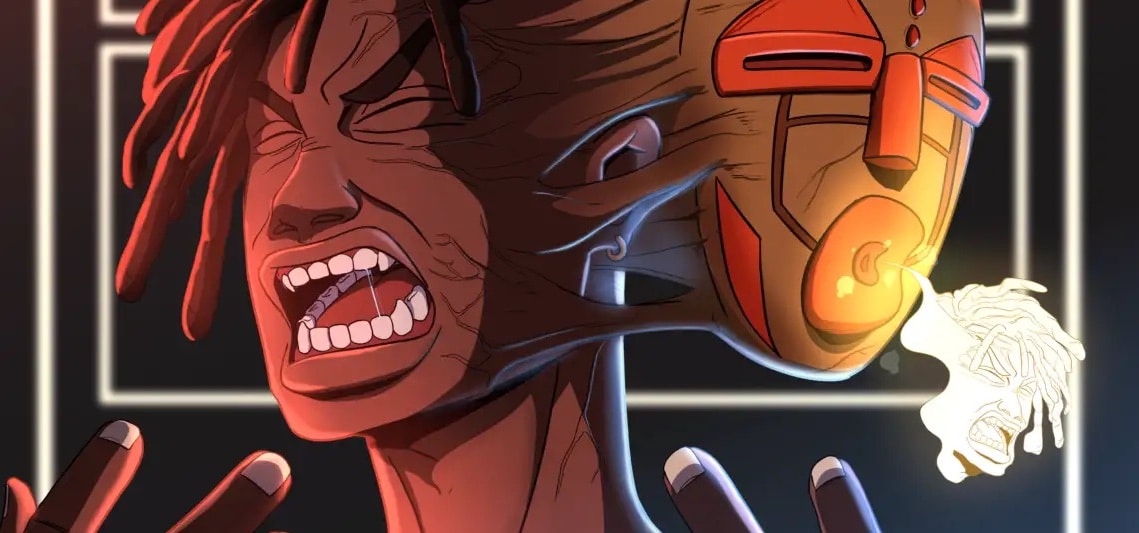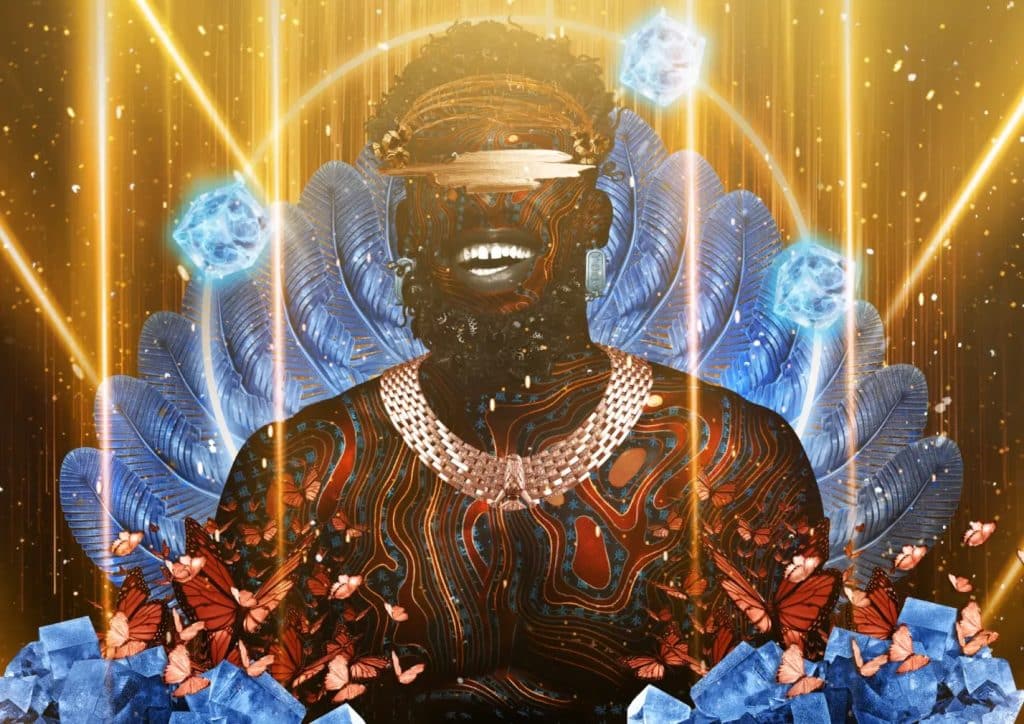
The audio app Clubhouse is widely seen as the cultural accelerator that helped cryptoart to flourish during the pandemic, thanks to a social dynamic built on connectivity and collaboration. Unfortunately, digital artist Vintagemozart’s experience of Clubhouse tells a different story.
In March 2020, the creator was invited to be a speaker on the platform, contributing to a talk about NFTs. “I was the only Zimbabwean in a group of 400 members, and while most of the participants claimed to know African art, they had no understanding of my connection to Afrofuturism,” he explains. “I was overshadowed and interrupted. Eventually I just went quiet.”
He only gained some traction when DarkMythst — aka the Ghanaian-born, California-based Afrofuturist artist Kwame Michael — entered the discussion. “He complimented me on my work,” says Vintagemozart, “but it still felt like I was an outsider, unable to enter a very closed space. Although I did make a few sales that day, I found it hard to participate in subsequent conversations. I didn’t have the right European or American accent. I didn’t have the social media following. It was always such a struggle to be heard. In the world of NFTs, endorsement is still assigned by a demographic that skews mostly male, white and from a Western background.”
Determined to set the wheels of change in motion, the artist made a decisive move. With a little help from DarkMythst and his loyal fanbase, he started an incubator called the African NFT Community, which offers cryptoartists from Africa and the African diaspora a robust infrastructure and nurturing environment for gaining visibility.
“Now we have over 30,000 members, mostly on Twitter where we host discussions five times a week,” says Vintagemozart, who prefers to go by his artist name since he sees himself as a facilitator rather than a spokesperson or arbiter. “I am not a politician. I am not here to tell people what to think. The community was founded to give a voice to African creatives and provide a social hub for artists.”
Vintagemozart’s own NFT series on 1stDibs, “Boys Don’t Cry,” was made as a response to a period of depression and anguish in his life connected to a feeling of uprootedness. Visually dynamic and inspired by the gritty noir aesthetic of graphic novelist Frank Miller’s Batman titles, the figurative artworks explore themes of isolation, alienation and confinement while offering a sense of recovery and resolution.
“The series has a chronology to it,” he explains. “As I go through this journey, the pieces get progressively lighter. The cubes represent the burden of melancholy, but there are also shards of light, offering hope and possibility.”
Vintagemozart describes his work as Afrofuturist, combining science fiction, mythology and fantasy to reimagine history and reclaim Black identity in a way that is optimistic, inspiring and transformative. “The native African experiences expressed through Afrofuturism make a unique point about colonialism,” he asserts. “They ask, ‘What would life be like if it hadn’t happened?’”
In his eyes, this thread also runs through the work fostered by the group. “Not all the artists consider themselves Afrofuturists, but to me, Afrofuturism is a feeling of optimism and hope rather than an aesthetic. The greatest thing about the African NFT Community is that it is so multicultural. It’s like an art library of inspiration — combining many different styles, languages, cultures and expressions — yet we are all going through a similar experience. For me, this really brought great comfort.”
The new 1stDibs NFT exhibition “True Face” takes a closer look at figurative work by several of the African NFT Community’s most talented cryptoartists. In addition to Vintagemozart, the show spotlights makers like South African VR/AI expert Kokky Tau, Nigerian multidisciplinary creator Kel Savage and Kenyan portraitist YoungKevArts.
Abieyuwa, a Nigerian-American artist, draws on her experience as a young Black woman and her Esan and Igbo heritage; Nigerian artist Philheal uses a graphic cartoon style to depict action-packed stories that honor communities and cultures close to his heart.
New York–based artist Nygilia, who also goes by the artist name futurefantasygal and runs the community’s social media platforms, refers to her style as fantasy futurism. “I’ve always been into all that is freely creative — blurs, glitches and textures feature strongly in my work, as do abstract interpretations of the human form,” she explains.
Her neon-pink piece in the exhibition, Eos Fuchsia, shows a female figure surrounded by flashing lines. “My characters are inspired by futuristic video games like Final Fantasy and The Legend of Zelda, where you see people of all different cultures unite for a greater cause,” she says.
Nygilia maintains that one of the most important functions of the African NFT Community is to create a safe space for new digital artists who may not know how to protect their output or indeed how to monetize it. “We’ve pushed our community forward so that we now have a strong, focused market for our work, one that no longer relies on the pillars of the traditional art world.”
Ghanaian artist Georgette Asiedu turns historical themes such as African dress and folklore into contemporary talking points with her series “Faces,” inspired by traditional African masks. Sculptural looking with strong talismanic overtones, these NFTs use signs of the zodiac to explore issues surrounding self-identity and mental well-being. According to the artist, her NFT aries awakening, which is included in the show, is one of the most complex works in her collection since it relates to the processual nature of self-identity.
“The piece features Akuaba, a traditional Fante fertility doll,” she says. “This doll can signify a lot of things, but in the context of aries awakening, I use it to signify the discovery of self, rebirth or the ability to be born. It is modified with the horns typical of an Aries and a single tear to signify relief. There is relief because [she] has a greater understanding of ‘self.’ As a result, more kindness is shown to Aries, which is why her heart is clutched. The traditional Akuaba doll stands, openhanded, but here [she] is crouching because the process of self-discovery takes time — ‘I’m not where I want to be just yet.’”
By contrast, Nigerian artist Jpearl King’s piece employs an ultraslick graphic style to express confidence and power in the form of a superhero composed of geometric patterns that verge on abstraction. “Blvck Lightning was made after a creative hiatus,” she notes. “I decided to try something different by bringing all the things I love to this new piece without restrictions. These include a matte black [palette] and strong contrasts between light and shade, as well as the form of the sword.”
For South African Mercy Thokozane Minah, cryptoart is a way to explore the subconscious and pave a path toward new ways of thinking about the future. In their AI piece tiny little steps i take to you/doesn’t matter if i fall, they explore the intersection between dreams and the digital realm.
“I always depict gender-expansive people — that is to say folks who are transgender, nonbinary and/or genderless,” the artist explains. “But beyond that, these figures aren’t necessarily human. They are dream deities, little gods that exist where the depths of our feelings, subconscious and obsessions rest. Someplace holy yet irreverent. The ‘smol’ or multiplied figure is a god of worship and devotion, one that moves slowly and tentatively but with resignation and purpose. The larger, singular figure is a god of opulence and assuredness, one that prefers their offerings in the form of devotion and complete surrender to their whims. Each deity happily serves their respective purpose toward the other.”
Afrofuturism is an exhilarating visual force in the work of AnjolaDave from Nigeria. His vibrant NFT Ego Death shows a cyborg illuminated by a halo of silvery beams and golden light holding what looks like a gleaming planet charged with an electric pulse.
As the artist explains, the work is imbued with energy, optimism, hope and zest: “The artwork conveys my transition from not knowing the reach of my abilities to knowing that my abilities are as infinite as I want them to be. Within the world of NFTs, I’ve faced a whole lot of challenges, but one that stands out is getting exposure as an African artist and getting my work to be valued the way it should.”
This chimes with a sentiment expressed by Vintagemozart, who sees the African NFT Community as a tool for education, advancement and elevation and considers Afrofuturism its guiding spirit. “Afrofuturism isn’t limited to a visual style, it is a feeling, a way of conveying a utopian message. The question is, How do you see the continent? How do you see the light? Artists can project this ideology as they see fit, be it through a minimalist cube of light or a sci-fi aesthetic — it is really theirs to own — but it’s always uniting.”
